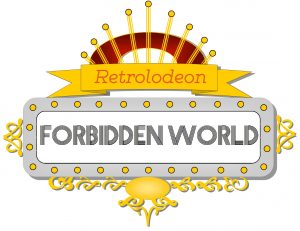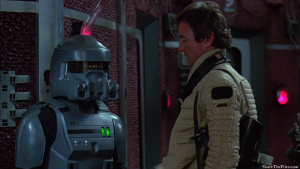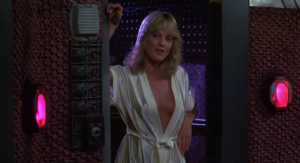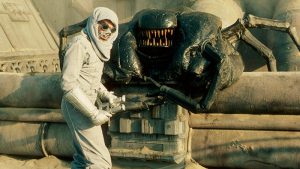
“Forbidden World” is cut from the same cloth as “Galaxy of Terror.” It was released a year after that film and was also produced by Roger Corman and distributed by New World Pictures. It too is a sci-fi horror acting as an “Alien” rip-off, this time much more overtly. It even recycles some of the same sets (designed by James Cameron) as a cost-cutting measure. They wisely shuffle it all around to make it seem different, but the lunch tray wallpaper gives it away. The desert planet of Xarbia looks incredibly similar to Morganthus, though it’s shot in daylight to give it a unique spin. The only big difference is that this film only boasts one creature: a gigantic worm beast with legs that, at times, resemble that of a crab, and other times come across as tentacles. Hmm…sounds like a certain worm creature from a previous Corman-produced sci-fi horror flick. At least nobody’s getting worm-raped this time around. (That’s a sentence I actually typed; what a world we live in.)
Okay, so there are two big differences. Whereas “Galaxy of Terror” ventured throughout a galaxy (technically just a planet, but I digress), “Forbidden World” is isolated to one location. A genetic research station located in the middle of Xarbia where scantily-clad female scientists mingle with heavily-clad male scientists, a horny security guard, and a couple of buff hotheads. They are responsible for the alien creature running amok, an experiment gone awry. Enlisted to aid them is professional troubleshooter Mike Colby (Jesse Vint), bringing along his robotic assistant SAM-104…despite having her turned off for the majority of the film. Was the stuntman manning the “Battlestar Galactica” offspring demanding too much money?

The action is contained mostly to the station, only venturing out into the desert on rare occasion. This helps set the film apart from its sci-fi horror brethren, giving the movie a claustrophobic bent. Thanks to this, I actually preferred this flick over “Galaxy of Terror” despite not being as bonkers. The simple story (cooked up by Jim Wynorski & R.J. Robertson and ironed out into a screenplay by Tim Curnen) prevents the happenings from being too obtuse and confusing. The hyper pacing runs much smoother as there’s not much content to get lost in the shuffle. Stereotypes make up the characterization and tension is derived from close quarters and simple alien maneuvers. There’s no confounding hypnosis here; just pure terror (not a galaxy of it, though).
That’s not to say the film is structured perfectly. Incorporated throughout are erratic flashbacks (or flashforwards, to be precise) that are prone to cause seizures. The love triangle between Colby, Tracy Baxter (Dawn Dunlap), and Dr. Barbara Glaser (June Chadwick) is framed so poorly that the conflict seems almost nonexistent. Baxter & Glaser come across as mere colleagues than friends, preventing their turmoil from fully taking off. It doesn’t help that it’s squashed almost immediately in favor of an alien attack. Not much time to be had squabbling over desires for an action hero that more strongly resembles a sitcom dad than anything else when an alien’s chasing after you. You’ve got to have your priorities straight.

Director Allan Holzman gets a lot of mileage out of the creature (comically nicknamed “Dingwhopper”). There are various POV shots from its perspective, spying on its next victims. At one point it watches Tracy Baxter undress for bed and tan nude in the sauna. Its salivation drips onto the camera lens, causing me to make a crack about an overexcited cameraman. Just as it’s about to pounce, possibly to engage in worm-rape (seriously, that’s a thing I have to keep referencing), its attack is averted by an incoming crewmember. Cinematographer Tim Suhrstedt cleverly hides the creature with dark shadows and low camera angles. This is all to build to the eventual reveal: the recently hatched alien/human hybrid’s transformation into a gigantic behemoth.
That’s right: Dingwhopper is part-human, part-alien. The scientists used the DNA of a dying human patient and mixed it with that of an animal (or a worm, as I am to believe) in an effort to create a cure to stave off a galaxy-wide food crisis. It’s a flimsy explanation, but one that produces gooey special effects, such as the aforementioned creature, another melting body in the form of the dying patient, and an animal shelter littered with mutilated animal carcasses. It also leads to ol’ Dingwhopper communicating with the scientists through the written word, though it’s not as emotionally touching as it was in Denis Villeneuve’s “Arrival.” Imagine that film with a lot more gore and gratuitous nudity.

“Forbidden World” is a goofy film no doubt, but it’s goofy fun from start to finish. It moves along at a brisk pace, playing host to tremendous special effects and not-so-tremendous special effects. The performances leave a lot to be desired, the dialogue coming across as stilted and awkward. The foreboding dread and scientific mumbo jumbo more than makes up for it, making for a cheesy good time. It’s a more compact version of “Galaxy of Terror” and I dug the hell out of it, warts and all!
Final Rating: B
